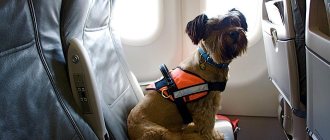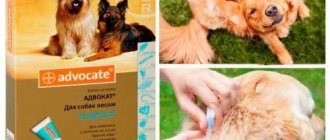Passports are available not only for people, but also for animals. They store basic data about the owner of the animal, the pet itself, information about vaccinations and treatments against parasites.
- Alternative documents
- Dog owner
The editors of Petstory tell you what a veterinary passport for a dog is, how to make it correctly, and what documents to fill out in order to take your pet with you on vacation.
Why do you need a veterinary passport for a dog?
A veterinary passport is needed to transport a pet on planes and trains, to participate in exhibition competitions and for sale. If you are going on vacation without your pet, then without a passport you can only leave it with friends. Official shelters and hotels do not accept animals without passports.
And even if your pet is a homebody, still issue him a document. In the veterinary passport, the veterinarian records all the dates of vaccinations, treatments against parasites and operations undergone. You don’t have to remember when you took this or that vaccination or whether you did it at all. The passport will serve as proof that your pet is vaccinated against rabies. This will help in conflict situations if the dog bites someone. And the most important advantage: if you have a passport, you can always prove that this is your pet. Below we will look at how to fill out a veterinary passport for a dog.
Is it necessary to obtain a passport?
Officially in our country there is no law requiring a passport for a dog. But you will not be able to carry out the official transportation of your pet without this document.
Price examples
Obtaining a veterinary passport is not so expensive, time-consuming or difficult if you choose the right clinic. You can use the services of institutions if you already have the results of any research. Then you won’t have to do some of the necessary tests, and registration will be faster and cheaper.
On average, for cities in the Central Federal District, obtaining a veterinary passport will cost 4,500 rubles . If necessary, you can microchip an animal - 1500 rubles . 1000-1500 lower if obtaining a passport is not so urgent.
For more accurate coverage of the issue of cost, you need to contact a veterinary clinic and familiarize yourself with its price list.
Internal veterinary passport
Let's find out how much it costs to get a dog passport and what information it contains, and also look at a sample dog passport.
A veterinary passport is issued free of charge; the form itself costs from 100 to 300 rubles. The price depends on the appearance and quality of the paper.
The veterinary passport states the following:
- photo of the pet;
- owner details (full name, address, telephone);
- description of the dog (name, breed, date of birth, gender, color, special features);
- vaccinations and parasitic treatments;
- identification number (chip or stamp number);
- additional medical data (diseases, surgeries, dates of estrus and mating, number of puppies born);
- for pedigree dogs, the pedigree number, breeder, brand or chip number are indicated.
In the field about vaccinations and treatments, the veterinarian writes down the date, the name of the drug, and attaches a sticker with the series and number of the drug. Manufacturers include stickers in some tablets. You can stick them on yourself and write down the date when you treated your dog. But to transport your pet you will need a doctor's stamp and signature. In this case, visit a veterinary clinic.
This is what a dog passport might look like. Ozon.ru
International veterinary passport
An international veterinary passport for dogs looks almost the same as a regular one. But all points are additionally written in English.
To travel abroad, your dog must be microchipped. This way you identify the animal and prove that you are its owner. According to international standards, a passport can only be issued for an identified dog.
There are also requirements for rabies vaccination. Your pet must have received it within the last 12 months. If you have not vaccinated your dog, do so at least 20 days before departure. Only after this can you microchip your dog so that the vaccination data is stored in the medical database using the chip number.
For international travel, just a passport is not enough. Carefully study how to properly import a dog into the country you are traveling to. Also call your departure airport to find out their transportation requirements. Some countries may have quarantine requirements for dogs arriving in the country. Sometimes it reaches three weeks. The UK has the strictest conditions.
Also, some countries may require that your animal be sterilized if it is not of breed value.
Fill out all items in clear, understandable handwriting without corrections.
Alternative documents
The Rosselkhoznadzor website provides the following list of documents for traveling with a dog: veterinary passport with data on all vaccinations and studies or veterinary certificate form No. 1 or veterinary certificate of the Customs Union form No. 1 when traveling to Belarus, Kazakhstan, Armenia and Kyrgyzstan.
Apply for a veterinary certificate, Form No. 1, or a veterinary certificate of the Customs Union, Form No. 1, immediately before your trip at state veterinary clinics, as they are valid for 5 days. These documents are issued free of charge.
To receive it you must provide:
- a dog for examination;
- passport with the dates of treatments and vaccinations recorded;
- a note on treatment against echinococcosis (tapeworms);
- the result of a scatological examination for helminth infections;
- requirements of the importing country into which the animal will be imported.
To obtain documents, start preparing your dog in advance. Visit your veterinarian 30 days before departure. If this is a private clinic, then it must have permission to vaccinate animals against rabies. After 30 days, visit the doctor again at a public clinic to receive a certificate or certificate.
To find out the veterinary requirements of the country you need, fill out the online form on the Rosselkhoznadzor website.
You may also need additional documents for travel. In the requirements for traveling to EU countries you can see a European certificate, and for other countries - a certificate of form No. 5a or documents agreed upon between Rosselkhoznadzor and the country of entry. To obtain them, contact the territorial office of Rosselkhoznadzor.
Sample veterinary certificate form No. 1
Sample veterinary certificate of the Customs Union No. 1
Sample certificate form No. 5a
Next, we’ll find out how to make a passport for a dog.
Who prepares the pedigree (RKF, SKOR)
Passport for a cat: how to make a cat veterinary document
Two cynological organizations are engaged in extracting pedigrees for huskies and other dogs - RKF and SKOR. The first places high demands on the purity of the breed. Its employees check the puppy's ancestors with special care, and culls are frequent. Getting a pedigree from RKF is not easy. It is better to find out from the breeder when purchasing what these RKF documents are for a dog, and whether it will be possible to obtain them.
The requirements for dogs whose owners contacted SCOR are less stringent. Here, according to some experts, there is a wrong attitude towards the selection of breeding individuals; the lines of descent are not pure. Because of this, owners cannot always exhibit a dog or go with it to an international competition. Pedigree from RKF is highly valued, there are no problems with it.
To avoid difficulties with breeding and registering litters, dog breeders are advised to also register with the RKF and submit the dog for testing (you need to participate in at least 3 exhibitions). If everything ends successfully, the dog is given a registered pedigree.
Pedigree SKOR
How to get a passport for a dog
Upon official purchase, the breeder must provide you with the dog’s veterinary passport with marks of the first vaccinations. In other cases, you will be issued a passport when visiting a veterinary clinic. You will need to pay for the document itself. Veterinary passport forms are also sold in pet stores. You can come to the veterinary clinic with the form, the doctor will explain how to issue a passport for the dog.
Subscribe to the newsletter and receive a discount from the Pet store
Thanks for subscribing!
An email with a promotional code has already been sent to your email.
How to correctly fill out a dog’s veterinary passport - sample
Now we will look at how to correctly fill out a dog passport
To travel abroad, all information must be entered or duplicated in English, the name of the animal must be indicated in Latin letters. There should be no torn pages in the passport. Fill out your passport in block letters using a black or blue pen.
You can enter some of the information yourself; the vaccination notes and identification of the animal are filled out by the veterinarian.
The photographs below show a sample of filling out a dog passport.
Dog owner
Indicate the name of the dog owner and his address.
Please note that there are several fields available for completion. A dog can have several co-owners. If one of your family members takes the dog on a trip, he must be included in the veterinary passport.
Description of the dog
Indicate the dog's name, date of birth, breed. Write the breed only if you know it for sure. If your dog is not purebred, then you need to write “mixed breed”. Next, indicate the gender: female or male. Next, indicate the color of the dog. Write down the exact color if you know. If not, describe it yourself: black, black and white, red, etc.
Deworming and treatment against ectoparasites
Fill out this item if you yourself give your dog pills for worms and ticks. Indicate the date and name of the medications. If the treatment is carried out by a doctor, he will enter all the information himself.
Vaccination information
The items “Vaccination against rabies” and “Other vaccinations” will be filled out by a veterinarian.
Notice how the doctor fills out the vaccination sections. He must indicate the date, attach a sticker with the name of the drug, sign and seal.
Below is a sample of how to fill out these pages in a veterinary passport for a dog.
Place of receipt and registration rules
A dog has a hot nose: causes and what to do
The passport is issued by a veterinarian at a state clinic. A blank form can be purchased locally and immediately given to a specialist to fill out the information. It is better to check on the spot how much this service will cost.
Sample of a blank international passport
Typically, a veterinary passport is obtained when the puppy is first vaccinated. After the procedure, a record of vaccination is added to the document. Therefore, most often the breeder receives a passport.
New passports are more convenient to use. In addition to information about medical treatments, they provide additional fields for notes and repetition of section names in international English.
Note! Any entry must be certified by the signature of a veterinarian and the seal of the medical institution, otherwise the data will not be included when passing control at the border. The seal of the kennel club is not enough to confirm the information.
What to do if you have lost your veterinary passport
The most important thing in a veterinary passport is information about the latest vaccinations for the year. If you haven’t done them for your pet, then you can simply get a new veterinary passport when you visit the veterinarian. To restore complete information, contact the veterinary clinic where your pet is usually seen. Data on rabies vaccinations and required vaccinations due to outbreaks of infectious diseases are stored in the general register for at least 5 years. And once a quarter, clinics submit data to the State Veterinary Supervision Authority, where they are stored for at least 10 years.
If your dog is microchipped, it will be easier to recover the data. It can be extracted from the EDB - a single database. Make sure your doctor enters your pet's chip identification number into the EDB. On subsequent visits to the veterinarian, find out whether he has entered information about the manipulations performed.
Puppy card
This ID card for your young animal is valid until the puppy reaches fifteen months of age. After this, the card must be replaced. This replacement is usually made by the dog's pedigree. Thus, to complete it, it is imperative that a professional dog handler evaluates the breed standard of your dog.
However, as for the metrics, all deviations from the standard, defects and other shortcomings must also be indicated there. In addition, the form must contain all the basic information about the pet and its parents. The card must be issued in accordance with the legislation of the Russian Federation and secured with the state seal.











